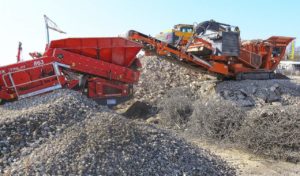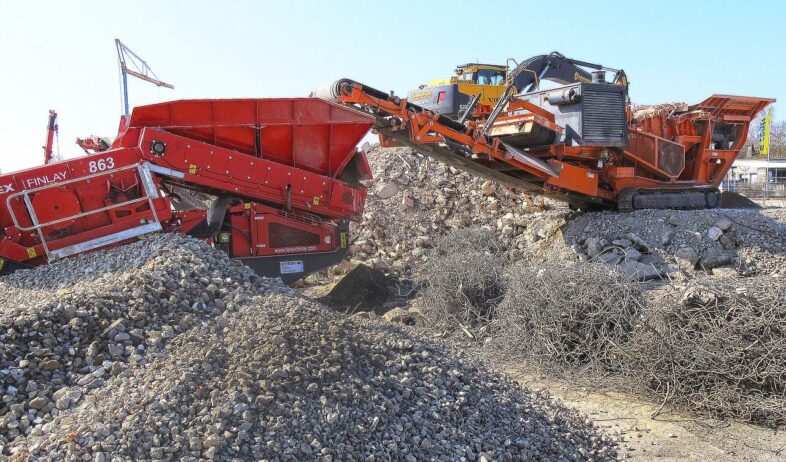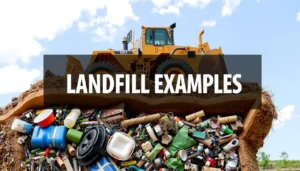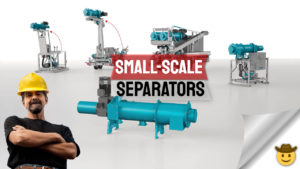Inert waste disposal should be simple and cheap, because there is no need to send it to a licensed landfill. But, do make sure it really is “inert” before you offer it to a farmer for improving farm access tracks, for example.
Inert materials are by definition un-reactive, both biologically and chemically. This means that when inert waste is disposed of it will not decompose at all. No change will occur other than possibly wear or erode physically or suffer from frost and heat expansion damage.
 This type of waste will not pose a threat to the environment, animals or human health and will not endanger the quality of water courses.
This type of waste will not pose a threat to the environment, animals or human health and will not endanger the quality of water courses.
But, that's not to say care is not needed. When there is a large amount of this type of waste, it can become an issue as it takes up a lot of space. If piled up in a bund, it might for example, rob a neighbour's property of light.
A lot of the waste that is considered to be inert is found to contain organic matter. Bits of wood, and all manner of green vegetable matter tend to get into it. Even these can later, if landfilled with other inert waste, cause leachate to be formed.
Inert Waste Disposal UK
The definition of inert waste is clear within the UK waste regulations. And, substantial volumes of inert waste are now recycled to avoid the cost of disposal.
In general, the assumption is that construction site soils, demolition materials etc., are waste unless it can be shown otherwise. Those that wish to dispose of inert waste in the UK must first show that it complies with the rules for an “inert” EWC Code, as in the table below.
However, much inert waste remains, which is disposed to regulated inert waste landfills. A further proportion is used for farm access track improvement etc., rather being recycled to provide a resource for industry. However, the best outcome is to reuse inert waste, for example as is being achieved by using Solid Waste Management Plans (SWMPs) for construction sites. These SWMPs actively assist construction industry businesses to improve their recycling rates.
These site operators provide inert waste disposal in the UK and are licensed to accept inert soils, clays, excavation materials and inert construction and demolition wastes.
The objective of Inert Waste Classification is:
- to assist in providing Waste Disposers with safe and efficient facilities at which to dispose of their wastes;
- and, to thereby help restore these sites to sustainable after-uses.
All inert landfill sites are regulated by local planning authorities (eg County Councils) and the Environment Agency (EA).
Is my waste inert?
In principle, the EA guidance defines “inert waste” as material having insignificant leachability and pollution content which will not require laboratory analysis. (A problem arises from “other materials”.)
For further information we suggest that as a starting point you visit the “Summary of Landfill Directive Waste Acceptance Procedures”, on the United Kingdom Parliament web site.
The United Kingdom Parliament web site also contains a table of inert materials, which we have duplicated here for convenience. (This list may change periodically – the user shall ensure that he checks that the information below is current and valid.)
Table 1 – LISTED INERT WASTES (UK)
EWC Code | Description | Restrictions |
10 11 03 | Waste glass based fibrous materials | Only without organic binders |
15 01 07 | Glass packaging | |
17 01 01 | Concrete | Selected C&D waste only |
17 01 02 | Bricks | Selected C&D waste only |
17 01 03 | Tiles and ceramics | Selected C&D waste only |
17 01 07 | Mixtures of concrete, bricks, tiles and ceramics | Selected C&D waste only |
17 02 02 | Glass | |
17 05 04 | Soil and stones* | Excluding topsoil, peat; excluding soil and stones from contaminated sites |
19 12 05 | Glass | |
20 01 02 | Glass | Separately collected glass only |
20 02 02 | Soil and stones* | Only from garden and parks waste; excluding top soil, peat |
* For the purposes of waste acceptance soil includes naturally occurring sands and clays.
This table may no longer be up to date. Each visitor must check source documents before using this table. | ||
Wastes listed in Table 1 are assumed to meet the definition of inert waste and can be admitted without testing at a landfill for inert waste. Wastes that are not listed must be tested to confirm that they comply with the limit values proposed in the Commission Decision Document.
We can help you define and carry out leachability trials. To contact us by email click here.
Comments on wastes which may be “inert waste” include:
- selected demolition waste – although the preferred option is to re-use and recycle this material;
- construction waste – may be inert if suitably source selected/segregated. Recycling and reuse is preferred, but the small quantities generated by many building sites often makes this uneconomic;
- uncontaminated soils and subsoils – not normally classified as a waste if reused;
- highways carriageway waste (scrapings etc) is not listed in Table 1, as it is usually classified as hazardous unless subject to leaching tests as heavy trafficking results in contamination from tyre and oil residues etc.
Understanding the UK Problems for Inert Waste Classification in 2019
The licensing of landfills for inert waste is a problem in the UK due a to a number of factors. All these combined are currently having the result that although the casual observer might expect there to be an abundance of inert waste disposal locations around the UK, there are in fact very few.
Truly inert waste can't harm the environment, you might reason. So, why wouldn't there be many cheap disposal sites available at a low gate fee cost?
The reason is that many have a vested interest in maintaining high gate fees.
In reality the main areas obstacles which arise to anyone seeking to open an inert waste landfill are:
- Conflict with the ideals of the circular economy.
- Conflicting forces are making the rules for licencing inert waste filling in old quarries in order to restore the levels of those to create usable land, and return it to beneficial use extremely difficult.
- Misclassification of waste.
1. Conflicts of Inert Waste Disposal with the New Circular Economy
Most inert waste is construction waste. If it was too cheap to dispose of construction waste as inert waste, the EU targets for the reuse and recycling of construction waste (e.g. crushed concrete being re-used in new concrete on-site) would never be met. It would be so cheap to transport it away from site that contractors would buy all new aggregates, and reuse and recycling targets would never be met.
2. Increasingly Impractical Rules for Licencing Inert Waste Filling in Old Quarries
In the past it has been accepted that to restore the levels of those to create usable land, and return it to beneficial use extremely difficult.
The rules which frequently appear to be illogical for using inert waste as infill to worked-out quarries make inert filling very difficult for worked-out quarry owners. This is due to a combination of changing EU policy, HMRC seeking a maximize their tax take, and local authorities seeking to defend local interests (NIMBY tendencies) using questions around inert waste classification to decline granting planning permissions for much needed quarry restorations. After such restoration these quarries can be converted to parks, and even new housing areas on occasions.
Gain a flavour for the sorts of problems which exist for old quarry backfilling/ inert landfill operation, by reading the following extract from a March 2019 article:
When Waste “Recovery” Becomes Waste “Disposal”
Source: Luke Prazsky, service director, waste resource management, Wardell Armstrong
“Only those sites that are classified and permitted as disposal activities are required to charge landfill tax on wastes being disposed (inactive wastes now £2.90/tonne). As a result, we saw a proliferation of these sites for restoration schemes up until a few years ago when we had the Methley decision at the end of 2015. Until this point the Environment Agency was happy to issue environmental permits for the deposit of waste as a recovery activity far more willingly.
We are also now seeing a number of sites, that were permitted as recovery activities under the old regime, looking to extend, but facing the very real prospect of having to become a landfill site. …
So, in summary, the operators of deposit for recovery facilities should not assume that because they have a recovery permit, they can necessarily easily extend their plans for a site without becoming a landfill.
I do broadly support the Environment Agency’s current approach as the industry needs an even playing field and the previous regime pulled the rug from under inert landfill sites. Many of these were mothballed or massively scaled back as a result, thus delaying their completion and the restoration of those areas of land.”
via wasterecoverybecomeswastedisposal
3. Misclassification of waste.
Misclassification of waste can occur at any point in the waste management chain. It typically occurs when organisations and/or individuals (either accidentally or deliberately) misclassify waste at
the point of transfer.
The financial implications of misclassification can be significant. For example, waste classified as ‘inactive’ is eligible for the lower rate of Landfill Tax, which, at £2.70 per tonne, is substantially
lower than the standard rate of tax of £86.10 (2017 rates) per tonne.
Misclassifying waste to avoid tax is potentially lucrative.
Similarly, if hazardous waste is misclassified as non-hazardous, it will command a far cheaper gate-fee. For example, it has been known for soil contaminated with heavy metals to be misclassified as clean excavated soil. via WasteCrimeEAS2017
You may wish to see our original Inert Waste page here.
Landfill Examples – Designs and Operation
Modern sanitary landfills integrate engineered systems for environmental protection, while bioreactor landfills boost waste decomposition for energy. Specialized secure landfills use double-liner systems for safety. Effective landfill designs maximise capacity via strategic materials and techniques, with advanced monitoring technologies ensuring compliance and sustainability. Discover fascinating landfill examples…
The Problem of Expansive Soils
The Problem of Expansive Soils: When building or buying a new house, property owners usually obsess over style, furniture, gardens, pools – but they can forget one critical factor: the soil. Expansive soils can cause damage to buildings. Research has shown that one in four houses in the US has been somehow affected by this. […]
Small-Scale Separators for Dairy Farms and AD Plants
New Small-Scale Separator is Big on Results Following the success of its acclaimed Separators since their launch in 2016, Borger has released a new, affordable, 25 m³/h model, suitable for dairy farmers with herds of up to 150 – and for small-scale biogas operators. The launch of this compact new Bioselect RC 25 Small-Scale Slurry Separators (which […]
The Skip Hire Operator's Duty of Care (UK) – Updated Legal Framework
Skip Hire operator's Duty of Care (UK) requirements for Skip Hire Service Companies are poorly understood by the public and even by some skip hire companies and other waste transport operators. Why the UK's Duty of Care Regulations Were Introduced for the Transport Sector Most nations suffer fly-tipping problems and the UK response has been […]









